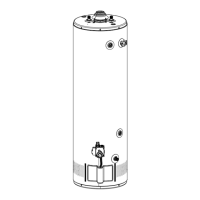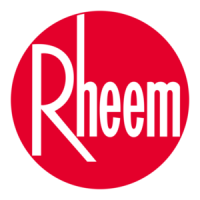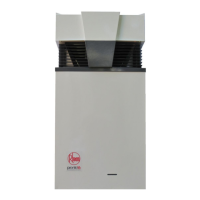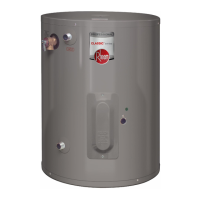Do you have a question about the Rheem PROG50-38N RH60 and is the answer not in the manual?
Warns that the water heater is not suitable for manufactured (mobile) homes.
Details safety measures regarding flammable materials and gas leaks.
Instructions for recording model/serial numbers and warranty proof.
Explains safety alert symbols and the meaning of DANGER, WARNING, CAUTION, and NOTICE.
Emphasizes the danger of not venting the water heater properly, including CO risk.
Warns against storing or using flammable materials near the appliance.
Details the risk of burns from water temperatures over 125°F (52°C).
Explains how to adjust the temperature dial and provides reference marks.
Highlights differences between LP and natural gas models and conversion warnings.
Outlines critical steps to take if a gas leak is suspected to prevent fire or explosion.
Stresses following manual instructions to minimize risks like fire, explosion, or injury.
Details California's requirement for bracing water heaters against earthquakes.
Lists essential safety checks, including gas shut-off valve location and appliance use.
Advises on avoiding areas prone to leaks, flammable vapors, or physical damage.
Specifies minimum clearances from combustible materials for different installation types.
Instructions for checking the water heater for damage and gas type verification.
Details the necessary air supply for combustion and ventilation in various installation spaces.
Warns against installing in environments with halogenated hydrocarbons that can damage the unit.
Explains thermal expansion and the need for expansion tanks in closed systems.
Guides on connecting cold and hot water lines, including shut-off valves and unions.
Covers pressure/temperature relief valve requirements and discharge line installation.
Instructs on filling the tank with water before operation and venting air.
Explains normal condensation and potential causes for persistent issues.
Details piping materials, shut-off valves, sediment traps, and connector types for gas supply.
Outlines methods for checking gas connections for leaks using soapy water.
Advises on disconnecting the heater during pressure testing of the gas supply system.
Addresses suitability and warnings for installations at high altitudes.
Emphasizes dangers of improper venting, including CO poisoning and fire.
Provides guidance and warnings on using external insulation blankets, respecting labels and openings.
Explains the purpose and installation of factory-installed heat traps.
Instructions for applying insulation to hot and cold water piping for energy efficiency.
Guidance on installing insulation for the Temperature and Pressure relief valve.
Lists critical actions to perform or avoid during water heater installation.
Verifies safe location, clearances, and air supply for the water heater.
Confirms water filling, purging, leak-free connections, gas supply setup, and testing.
Ensures proper installation and function of the relief valve and venting system.
Provides supplemental instructions for dual-purpose heating systems.
Warns against using chemicals from boiler systems in potable water to prevent contamination.
Essential safety checks, including smelling for gas and avoiding electrical switches.
Detailed instructions for safely lighting the pilot light using the piezo-electric system.
Instructions for shutting off the gas supply to the appliance.
Lists critical safety actions like shutting off gas, filling the tank, and keeping area clear.
Reemphasizes the danger of hot water and recommends lower settings for vulnerable users.
Explains how to set the thermostat for optimal temperature and energy savings.
Explains how temperature varies and the phenomenon of 'stacking'.
Describes built-in safety features and actions to take if overheating occurs.
Provides instructions for draining the tank, emphasizing safety with hot water.
Recommends periodic inspection of gas control, burner, relief valve, and venting.
Stresses keeping the area clear of combustibles and maintaining proper clearances for airflow.
Guides on inspecting the vent system and chimney for proper function and safety.
Details annual inspection of pilot and main burners and caution regarding cleaning.
Instructions for preparing the water heater for extended periods of non-use, including draining.
Explains the anode rod's role in tank protection and the need for inspection.
Addresses causes and solutions for condensation and yellow flames/soot.
Covers issues with lighting the pilot burner and it not staying lit.
Troubleshooting steps for rumbling noises and relief valve popping or draining.
Solutions for insufficient hot water, water being too hot, and main burner ignition failures.
Details the information required when ordering replacement parts for the water heater.
Advises contacting installer, contractor, or local utility first for service needs.
Provides contact information and required details for the manufacturer's service department.
| BTU Input | 38, 000 BTU/hr |
|---|---|
| Diameter | 20.25 inches |
| Vent Type | Atmospheric |
| Fuel Type | Natural Gas |
| Warranty | 6 Years |
| Capacity | 50 gallons |












